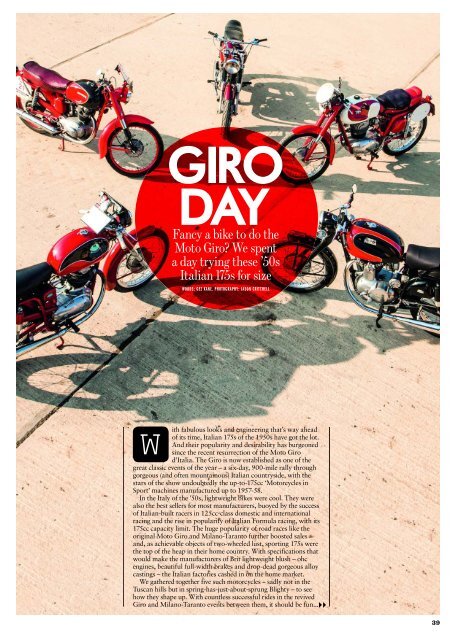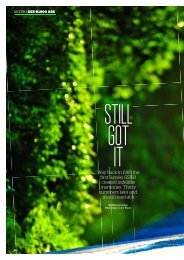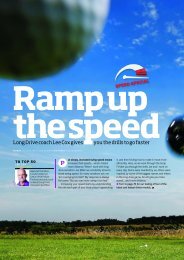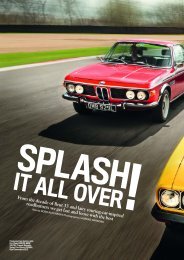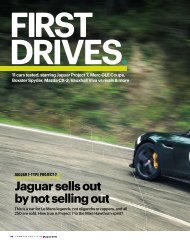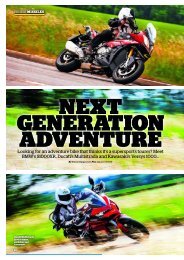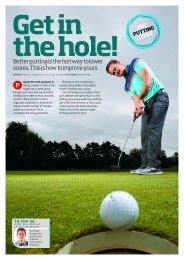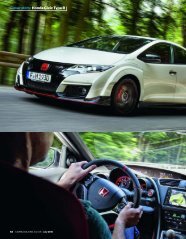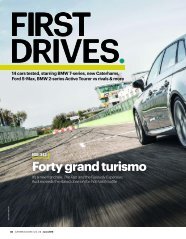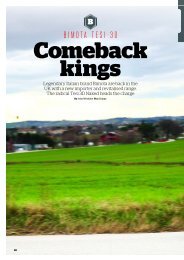You also want an ePaper? Increase the reach of your titles
YUMPU automatically turns print PDFs into web optimized ePapers that Google loves.
<strong>GIRO</strong><br />
<strong>DAY</strong><br />
Fancy a bike to do the<br />
Moto Giro? We spent<br />
a day trying these ’50s<br />
Italian 175s for size<br />
WORDS: GEZ KANE. PHOTOGRAPHY: JASON CRITCHELL<br />
W<br />
ith fabulous looks and engineering that’s way ahead<br />
of its time, Italian 175s of the 1950s have got the lot.<br />
And their popularity and desirability has burgeoned<br />
since the recent resurrection of the Moto Giro<br />
d’Italia. The Giro is now established as one of the<br />
great classic events of the year – a six-day, 900-mile rally through<br />
gorgeous (and often mountainous) Italian countryside, with the<br />
stars of the show undoubtedly the up-to-175cc ‘Motorcycles in<br />
Sport’ machines manufactured up to 1957-58.<br />
In the Italy of the ’50s, lightweight bikes were cool. They were<br />
also the best sellers for most manufacturers, buoyed by the success<br />
of Italian-built racers in 125cc-class domestic and international<br />
racing and the rise in popularity of Italian Formula racing, with its<br />
175cc capacity limit. The huge popularity of road races like the<br />
original Moto Giro and Milano-Taranto further boosted sales<br />
and, as achievable objects of two-wheeled lust, sporting 175s were<br />
the top of the heap in their home country. With specifications that<br />
would make the manufacturers of Brit lightweight blush – ohc<br />
engines, beautiful full-width brakes and drop-dead gorgeous alloy<br />
castings – the Italian factories cashed in on the home market.<br />
We gathered together five such motorcycles – sadly not in the<br />
Tuscan hills but in spring-has-just-about-sprung Blighty – to see<br />
how they shape up. With countless successful rides in the revived<br />
Giro and Milano-Taranto events between them, it should be fun...<br />
<br />
39
<strong>GIRO</strong> <strong>DAY</strong><br />
Q Narrow, nimble Mondial<br />
begs you to thrash it everywhere<br />
1957 MONDIAL 175 TV<br />
RACE-BRED, REVVY AND BEAUTIFUL TO BEHOLD<br />
Engine Air-cooled, 173cc, sohc single Chassis Steel single downtube cradle-type frame The numbers 10bhp, 70mph, 120kg (264lb), £5000-£6000<br />
Mondial punched well above its weight on the world stage, with<br />
the Bologna-based concern’s works racers racking up five world<br />
titles between 1949-57, plus victories in the Milano-Taranto and<br />
Moto Giro d’Italia. And their racing experience heavily influenced<br />
their road bikes. All of which is the attraction of the marque to<br />
Italian enthusiast Giuseppe Garozzo. Now a resident of Sidcup –<br />
where he ran a successful motorcycle dealership for many years –<br />
Giuseppe remains as enthusiastic about Italian metal as he was<br />
when he was a 10-year-old in his native Sicily.<br />
“Growing up in Catania, I was fascinated by bikes,” he says.<br />
“The range of lightweight machines being produced then really<br />
made a mark on me. They were beautiful. And, because I was so<br />
into the racing, the Mondial’s racing heritage really attracted me. I<br />
remember rushing home from work to listen to the day’s results<br />
from the Giro back in the ’50s, so when the event was revived in<br />
2001 I had to compete. I rode every event from 2002-2013 – and<br />
I’ve finished fourth overall twice on this bike.”<br />
Giuseppe has owned the TV for about five years. “Tom [Bolger,<br />
another of our test bike owners] called me and asked if I’d go to<br />
Italy to look at a bike to buy,” he recalls. “I already owned an<br />
earlier model of TV and quite liked it – but I was less happy about<br />
the staid styling so I said to Tom that I’d go with him on the<br />
condition that, if he didn’t buy the bike, I would. In the event, Tom<br />
bid the owner 4500 euros, but didn’t want to pay any more. The<br />
owner was firm at 5000 euros, so I bought it at the asking price.”<br />
The bike looked good. “It was much as it is now cosmetically,”<br />
says Giuseppe. “But although the seller said he had restored it, I<br />
wanted to be certain everything was right, so I stripped it. He’d<br />
done a pretty good job, but one of the valves was on the way out<br />
and the bore was a bit worn, so I wanted to sort those out properly.”<br />
That’s when Giuseppe realised the full extent of the problems<br />
facing would-be Mondial restorers. “Parts are so difficult to<br />
source,” he says. “I couldn’t find an oversize piston and rings<br />
anywhere. In the end, I had to have a new, undersized liner made,<br />
turn down the diameter of the existing piston a fraction and take<br />
some metal off the original rings to get the right gap. I found a<br />
Yamaha valve that was similar to the Mondial part and machined<br />
that down to fit. You have to be resourceful to run a Mondial.”<br />
“But the bike is so beautiful, it’s worth taking a bit more trouble<br />
over. I’ve tried to keep it as original as possible. I still run it on<br />
points ignition and it’s done 15,000 miles since I’ve owned it. With<br />
Mondial’s racing heritage, how could I resist?”<br />
Left-side kickstarts are the order of the day on Italian<br />
lightweights of this era and the Mondial needs only a gentle swing<br />
to burst into surprisingly noisy life. It sounds like the race-bred<br />
thoroughbred it is. A fair few revs are vital to make a brisk<br />
getaway, but once on the move, keeping the free-revving engine on<br />
the boil using the sweet down-for-up gearbox is a delight.<br />
The bike is so narrow, light and nimble, I feel I could almost<br />
ride it flat out everywhere – and the full-width brakes are pretty<br />
effective at scrubbing off a bit of speed should the occasion<br />
demand. After 200 miles of a Giro stage, maybe that seat wouldn’t<br />
feel quite as great as it looks, but on the sort of roads we’re riding<br />
today – a mixture of minor B-roads and unclassified lanes – I<br />
really feel the Mondial is all I need.<br />
OWNING ONE: Go for completeness, counsels Giuseppe.<br />
“Because Mondial were a fairly small-scale producer, parts are<br />
scarce. But because of that, models like this are appreciating in<br />
value and it makes sense to spend a bit to keep them in good<br />
condition. You’ll either need a contact in Italy to source whatever<br />
is remaining, or get parts re-manufactured.<br />
40
‘I’VE FINISHED<br />
FOURTH OVERALL<br />
IN THE <strong>GIRO</strong> TWICE<br />
ON THIS BIKE’<br />
Giuseppe Garozzo<br />
41
???????????????<br />
‘I GOT STUCK IN AND<br />
THE RESTORATION<br />
TOOK JUST FOUR<br />
MONTHS’<br />
Chris Bushell<br />
42
Q Pure Ducati: Desmo<br />
valve gear, taut handling<br />
1957 DUCATI 175T<br />
FUN AND RELIABLE IF SHIMMED UP CORRECTLY – AND YOU CAN GET PARTS!<br />
Engine: Air-cooled, 174cc, sohc single Chassis: Steel, tubular open-cradle type The numbers: 11bhp, 68mph, 104kg (230lb), £5000<br />
Chris Bushell has built his Ducati 175T to be ridden – and that’s<br />
exactly what he’s done since he restored it over the winter of<br />
2001-02. Chris was converted to Italian bikes in 1980 when he<br />
bought a Morini 3½. “That was the thin end of the wedge,” he<br />
smiles as he prepares to hand over his 175T to me. “I bought my<br />
first Ducati in 1992 and since then I’ve only owned Ducatis.”<br />
Chris has ridden nine Moto Giros on this bike, so I reckon it<br />
will be well up to our ‘Mini Giro di Kent’ today. With the beveldrive<br />
ohc engine blatting away healthily beneath me, first<br />
impressions are good. The Ducati feels bigger than it is thanks to<br />
the braced scrambles-type ’bars Chris has fitted to give a more<br />
comfortable riding position for long days in the saddle.<br />
Acceleration is lively enough to keep out of the way of modern<br />
traffic on the backroads and the handling is taut and predictable.<br />
After a winter layoff, the brakes could probably stand a little<br />
fettling, but with a mere 104kg to haul up I’m sure they’ll be fine<br />
after a little bedding in. Keeping the revs above 6000rpm liberates<br />
the best of the power and, though I have to drop to third for a<br />
couple of hills, it’s great fun keeping the motor spinning in its<br />
sweet spot. By the time we’ve covered a few miles, I’m really<br />
getting into it – sticking close to the bike in front, slipstreaming<br />
and keeping the throttle pinned through bends, it’s hard to believe<br />
just how much fun you can have at modest speeds.<br />
So how did Chris turn a £490 autojumble buy into a Moto Giro<br />
veteran? “It certainly sounds like a bargain now,” he admits.<br />
“I had bought a 125 Sport and rode that in the first of the revived<br />
Moto Giros in 2001. I was the only English rider there. I had a<br />
great time, but the 125 really struggled on some of the hills and<br />
I started to look for a 175. I spotted this one at Netley Marsh in<br />
2001. It looked terrible, but amazingly it ran. I stripped it right<br />
down and got the frame and all the tinware blasted and painted.<br />
It wasn’t as bad as it looked and everything was repairable.”<br />
Chris was pretty lucky with the engine, too, conceding: “It was<br />
reasonable. I had to source new primary drive gears and I replaced<br />
every bearing, seal and gasket. I also renewed the valve guides and<br />
seats and rebored the barrel to suit an NOS piston and rings but,<br />
like any Ducati, I spent most time shimming up the rebuilt engine.”<br />
Shimming up Ducati engines is a mix of art and science,<br />
according to Chris. “You get a feel for it after you’ve done it a few<br />
times. You need the right tools – micrometer, vernier calipers,<br />
vernier depth gauge – and a genuine manual. I buy any Ducati<br />
manuals I see and, fortunately, I had an English language copy for<br />
the 175T. It takes time and patience to set up the end float<br />
accurately, but once you’ve got it right, the engine is super reliable.<br />
The engine of this bike has only been apart once since 2001 – and<br />
that was just to clean out the integral sump.”<br />
Like many Giro riders, Chris has opted to stick with coil<br />
ignition, valuing the ease of roadside repairs over an electronic<br />
replacement. “I fit a new condensor before each Giro and carry<br />
spares,” he says. “I got stuck in and the restoration took just four<br />
months. The bike was ready for the 2001 Moto Giro and it made<br />
the event so much easier and more enjoyable. Since then, it’s never<br />
let me down and it’ll cruise all day at 55-60mph.If you steer clear<br />
of dual carriageways and motorways, it’s a very usable bike.”<br />
OWNING ONE: Good parts availability is one good reason to<br />
go for a Ducati, says Chris. “There are a lot of common parts on<br />
models built from 1957-68. I get most engine parts from Jonathan<br />
White in the USA (provajon@gmail.com) or Road and Race in<br />
Australia (roadandrace.com.au). Paul Klatkiewicz of Ducati<br />
Technical Services (01924 860210) or Nigel Lacey (laceyducati.co.<br />
uk) are very helpful. A project will cost at least £1500-1800.<br />
43
<strong>GIRO</strong> <strong>DAY</strong><br />
Q Racing crouch is<br />
advisory at 8000rpm-plus<br />
1956 PARILLA LUSSO VELOCE<br />
VISUALLY STUNNING RACER FOR THE ROAD, WITH AN ENGINE THAT’S A WORK OF ART<br />
Engine: Air-cooled, 174cc ohv single Chassis: Steel, tubular open-cradle type The numbers: 14bhp (est), 70mph, 100kg (220lb), £6500<br />
It looks as Italian as pasta, yet the marque’s founder was Spanishborn.<br />
At first glance you’d swear it has an ohc engine, but a closer<br />
look reveals it’s a high-cam ohv unit. The Parilla story may be full<br />
of quirks and contradictions, but there’s no denying that Tom<br />
Bolger’s 175cc Lusso Veloce is a stunning motorcycle.<br />
Tom says: “I’m a relatively recent convert to Italian bikes.<br />
I bought an MV Agusta 750 Oro (the first, limited production<br />
version of the F4) in 1999. I entered the 2005 Moto Giro on it, but<br />
it was a disaster. All these little bikes kept flying past me on the<br />
outside on the tight hairpins of the mountain descents. I thought:<br />
‘I’ll have to get one of those,’ and started looking when I got home.”<br />
Tom knew Mike McGarry – who runs a Parilla website – and<br />
contacted him. “I knew about Parilla’s racing history,” says Tom.<br />
“And I really liked the look of them. Mike knew a guy in North<br />
Wales who was selling one, so I bought it. It was a non-runner and<br />
leaked oil like a sieve, but it was complete and quite tidy. I stripped<br />
the engine completely and got to work as soon as I got it home.”<br />
The Parilla engine is a work of art. “For the mid-’50s this is an<br />
amazing little machine,” says Tom. “They were racers on the road.<br />
The high-cam design, with its unusual single-lobe camshaft,<br />
means the engine revs to 8000rpm-plus, and the gearbox is a<br />
cassette-type that you can remove with the engine in the frame.<br />
I’ve fitted a hotter X1 cam and a big-valve MSDS racing head I<br />
found in the States. I’m running a 22mm carburettor (standard is<br />
20mm), but some owners go up to a 25mm. Power is definitely up<br />
compared to a standard motor, but I don’t know by how much.”<br />
Tom has incorporated other subtle yet practical modifications.<br />
“The ignition is a Power Dynamo electronic set-up and the stock<br />
two-plate clutch is a known weakness. Gary Emmerson<br />
(motoparilla.co.uk) makes a kit to allow you to fit a seven-plate<br />
Ducati clutch, but you do need to use the later, wider clutch cover.”<br />
With the cosmetics of the bike already in good order, Tom was<br />
ready for a more enjoyable Giro in 2006, riding the Lusso Veloce<br />
in the prestigious historic class. And he’s stuck with Parilla power<br />
since then. “I parked up next to another Parilla at the end of a<br />
hard day’s stage at last year’s event and the owner couldn’t believe<br />
I’d just finished the stage,” Tom says. “He thought I’d cleaned my<br />
bike before parking it up. His bike was covered in oil, but mine<br />
doesn’t leak a drop. It’s all about careful preparation.”<br />
Barrelling along a Kentish lane on Tom’s bike, I soon realise he’s<br />
right about the bike feeling just like a racer on the road – the little<br />
bike feels taut and responsive as I snick through the gears and<br />
swing through bends, trying my best to avoid scrubbing off an<br />
ounce of speed by touching the excellent full-width brakes.<br />
The ’bars are narrow and low, positively encouraging a racing<br />
crouch to maximise the effect of the tiny frontal area of the<br />
Parilla. And that clutch conversion is worth every penny –<br />
whatever it cost. With Tom exhorting me to use a few more revs,<br />
I really appreciate its silky-smooth action and the ease with which<br />
I can juggle revs and ratios to maximise velocity.<br />
My ride on Tom’s Parilla has really opened my eyes to the<br />
potential of this little bike. I can easily see why Tom loves nothing<br />
better than hammering it round the Moto Giro for six days at a<br />
time. Smooth, sophisticated and oh-so stylish, this isn’t just a great<br />
lightweight machine, it’s a great bike – full stop.<br />
OWNING ONE: Though Parillas are rare (and consequently not<br />
cheap), there are still bargains to be found in the USA and Italy,<br />
according to Tom. “You shouldn’t need many spares anyway,” he<br />
claims. “You can find just about everything if you look hard<br />
enough and some parts are being re-manufactured.” A good<br />
ready-to-ride Lusso Veloce will cost around £5000-£6000.<br />
44
‘FOR A BIKE MADE<br />
IN THE MID-’50S, IT’S<br />
AN AMAZING LITTLE<br />
MACHINE’<br />
Tom Bolger<br />
45
???????????????<br />
‘I BOUGHT THIS<br />
BIKE TO GET INTO THE<br />
<strong>GIRO</strong>, BUT I SOON<br />
GREW TO LOVE IT’<br />
Chris Halfknight<br />
46
Q Comfy position and torquey<br />
engine make 200-mile days a doddle<br />
1958 MV AGUSTA 175 AB<br />
A CLASS ACT AND A GREAT ALL-ROUNDER FOR THE <strong>GIRO</strong> (APART FROM THE SEAT)<br />
Engine: Air-cooled, 172cc, ohv single Chassis: Steel, tubular open-cradle type The numbers: 7.5bhp, 60mph, 123kg (271lb), £6000<br />
If a bike can hold the key to redemption, Chris Halfknight’s MV<br />
Agusta is one machine that does. An increasingly hectic period<br />
spent thrashing big-bore sports bikes at licence-threatening speeds<br />
has given way to a passion for Italian lightweights – and the roadbased<br />
events in Italy that are tailor-made for them. “I’ve packed<br />
up the sports bike,” smiles Chris. “I don’t even ride much in the<br />
UK any more. Events like the Giro and the Milano-Taranto have<br />
spoiled me. I can’t get enough of them. I’m even learning Italian.”<br />
That’s serious. Just what changed the mindset of the former<br />
rocker? “Blame Tom Bolger,” Chris laughs. “He knew I’d been<br />
blasting around on sports bikes, but he suggested I give the Giro a<br />
go. I’d never even heard of it, but I agreed to give it a go when Tom<br />
told me he knew of an MV for sale in Essex. We went over to have<br />
a look and that was the start of it. The owner said the crank had<br />
run a bearing, but that he’d had another crank modified to take a<br />
Kawasaki roller-bearing big-end that he’d include with the deal.<br />
I took a chance, brought the bike home and stripped the engine.”<br />
A pushrod single held no terrors for former Jaguar mechanic<br />
Chris. “It’s really the simplest engine to work on,” he confirms. “If<br />
you can manage a Honda CG125, you can manage one of these.”<br />
Once he was inside the engine, Chris realised things weren’t as bad<br />
as the previous owner had believed. “The original crank, with its<br />
white-metalled big end, wasn’t in bad condition at all,” he says.<br />
“The main problem was a bent exhaust valve. There was even a<br />
nearly-new piston and rings. I replaced the bent valve, fitted the<br />
roller-bearing crank as a precaution and re-assembled the engine.”<br />
Tom had told Chris about the benefits of the Power Dynamo<br />
electronic ignition systems and he was keen to fit one to the MV.<br />
“The problem was that Power Dynamo don’t produce a kit to suit<br />
the Model AB,” he says. “But a chance conversation with a guy at<br />
the Bristol classic show led to him offering to make me a one-off<br />
adaptor to enable me to use a kit intended for an earlier CSTL<br />
model. The self-generating Power Dynamo system is brilliant.”<br />
Owning an MV would be enough for many people, but for<br />
Chris, the real draw is the events he gets to ride on his immaculate<br />
red and white AB. “I’m really competitive,” he admits. “The Giro<br />
is a real riding experience. The time schedules are so tight, you<br />
have to ride flat-out all day. I love it. A pre-’59 175 is what you<br />
need to get in, so I’ve got one. But I soon grew to love the bike.<br />
“It’s the best bike I’ve ever owned,” announces Chris with all<br />
the zeal of a true convert. “I’ve finished six Giros and a Milano-<br />
Taranto on it. I won my class in the 2012 Milano-Taranto and<br />
finished fifth overall, as well as winning a couple of the daily time<br />
trials. That’s not bad going from a little ohv model.”<br />
As I head off up the road, I appreciate its qualities almost at<br />
once. The handlebars are flat and comfortable, the Air Hawk air<br />
cushion seat cover transforms the narrow stock seat (“a hard seat<br />
will kill you on the Giro,” says Chris) and the pleasantly torquey<br />
engine makes 50-55mph cruising easy – and enjoyable.<br />
There’s a feeling of quality about the MV, too. There’s a<br />
reassuringly solid feel to the ride, the handling is more than a<br />
match for the modestly-tuned engine and the brakes offer dramafree<br />
stopping. This is a bike I could happily tackle the Giro on.<br />
OWNING ONE: The owners’ club should be your first stop for<br />
parts. New Old Stock spares are getting rarer, but the club<br />
(mvownersclub.co.uk) hold stocks and re-manufacture some hardto-find<br />
parts. “Italy is definitely the place to go for bargains,<br />
though,” counsels Chris. “Italians just don’t seem to buy this sort<br />
of bike, so you can still find good buys. I’ve found that the<br />
websitemoto.it/moto-epoca is a good place to find bikes. A budget<br />
of around £5000-£6000 should find you a good one.”<br />
47
<strong>GIRO</strong> <strong>DAY</strong><br />
Q Not the fastest or most<br />
elegant, but a fine Giro steed<br />
Q Bike is a veteran of<br />
CB-sponsored Mini Giro GB<br />
1954 MOTO MORINI TOURISMO<br />
A DEFINITE CONTENDER FOR ‘IDEAL FIRST MOTO <strong>GIRO</strong> BIKE’<br />
Engine: air-cooled, 172cc, ohv single Chassis: Steel, tubular open-cradle type The numbers: 5.8bhp, 58mph, 101kg (223lb), £3500<br />
The Moto Morini Tourismo clattering busily away beneath me<br />
may not be the most exotic – or, indeed expensive – of our mini<br />
test fleet today, but it certainly scores highly on rider friendliness.<br />
A home-made small-end bush that’s on the way out after five years<br />
of hard use explains the rattly top end, but its excellent ergonomics<br />
and torquey power delivery make me feel instantly at home on it.<br />
Proudly wearing peeling numberplates from the Classic Bikesponsored<br />
Mini Giro Great Britain in 2009, Pete di Pasquale’s<br />
black and red Tourismo amply proves the point that you don’t<br />
need the fastest, most collectable or most valuable machine to<br />
thoroughly enjoy the world of Italian lightweights. The gearlever<br />
has a fairly long throw, but with fourth gear in the up-for-up<br />
gearbox engaged, there’s little need to change down, save for the<br />
biggest hills. That softly-tuned little ohv engine just keeps<br />
chugging away. And, though the brakes are ‘only’ half-width hubs,<br />
they’re quietly effective – as I discover when I roll over a brow to<br />
be confronted with a steep drop and right-angle bend. If I was<br />
heading off to Italy to tackle my first Giro this year, I’d be very<br />
pleased to have a bike like Pete’s Morini to share it with.<br />
As you might guess from his name, Peter di Pasquale has more<br />
than a drop of Italian blood in him. In fact, his Christian name is<br />
Piero and he was born in Terni – the home town of the club that<br />
revived the Moto Giro d’Italia back in 2000. There’s no way Pete<br />
– a Kent resident for more than 30 years now – wasn’t going to<br />
take in a Giro or two. And in 2000, he got the call from Giuseppe<br />
– another of today’s band of brothers. “The trouble was,” Pete<br />
recalls, “I didn’t have a bike to do it on. So I started looking and<br />
spotted this Morini for sale in the VMCC magazine.”<br />
Pete offered the owner a swap for a Benelli 254 and a deal was<br />
done. “I don’t know if I got the best of it, though,” he continues.<br />
“The Benelli was on the button, but the Morini was in a bit of a<br />
state. Still, I had a Giro-eligible bike and two months to sort it out.<br />
The dynamo was faulty and I couldn’t find a replacement in time,<br />
so I took a spare battery and charger and charged the battery<br />
every night. I made it through three days like that. The following<br />
year the electrics burnt out completely and the engine seized, so I<br />
vowed to sort the bike out properly before the next event.”<br />
Pete bought a replacement dynamo and a spare engine. “I<br />
thought I’d sort the spare engine and fit that,” he says. “Then I<br />
could go through the original engine and make a proper job of it.<br />
The ‘new’ engine needed a piston and I couldn’t find one<br />
anywhere, so I bought a pair of NOS BSA A7 pistons – the A7 has<br />
the same bore and stroke – and used one. The BSA gudgeon pin is<br />
a larger diameter than the Morini one, so I had to machine some<br />
brass bushes to suit. I should have used bronze, but I couldn’t find<br />
any at the time. The brass bushes have lasted five years, but they’re<br />
about shot now. That’s why the top end is rattling so badly.”<br />
But now the original engine is ready to go back in. “I’ve fitted a<br />
new conrod with the flywheels bored to accept the A7 gudgeon<br />
pin,” he says. “It also needed a new gearbox selector shaft and I’ve<br />
made up new bushes for the rockers. The lubrication to the rocker<br />
shafts is a bit marginal, so they wear. I’ve also got Power Dynamo<br />
ignition for it, so it’ll be good to get it back in the bike now.<br />
“It might not be the fastest bike in its class, but it comfortable<br />
and reasonably torquey – two important attributes for a bike<br />
you’re spending six long days on. The tank is usefully large and<br />
fuel consumption is great. I can get 70mpg from mine.”<br />
OWNING ONE: Spares are getting rare, although North<br />
Leicester Motorcycles (northleicestermotorcycles.com) can help<br />
with some parts. The simple, under-stressed engine is easy to work<br />
on but you do need to check the oil feed to the rockers.<br />
48
‘IT’S COMFORTABLE<br />
AND FAIRLY TORQUEY<br />
– BOTH IMPORTANT<br />
FOR THE <strong>GIRO</strong>’<br />
Piero (Peter) di Pasquale<br />
49
HOLY CHRIST, I<br />
thought I was<br />
going to die!”<br />
When the man<br />
uttering the<br />
sentiment is one<br />
Michael Rutter<br />
Esq., whose CV of<br />
road racing achievements is<br />
longer than most people’s life<br />
story, you take notice. It must<br />
take something pretty hairy to<br />
widen the eyes of a 13-times<br />
NW200, eight-times Macau and<br />
four-times TT winner.<br />
On this occasion, though,<br />
we’ve merely ridden five miles<br />
across town to fill up at a garage.<br />
Michael smiles. “There are<br />
usually fewer cars around when<br />
I’m on a bike,” he explains.<br />
Rutter, myself and Johnny<br />
Mac brim the three red machines<br />
before heading off for a day<br />
tearing Lincolnshire a new one.<br />
As I pay for the fuel I look out<br />
over rows of chewing gum, and<br />
across at the forecourt where the<br />
Yamaha R1, Ducati 1299 S and<br />
BMW S1000RR are gathered<br />
round the pump, huddling in a<br />
conspiracy of outrageous<br />
performance.<br />
I run through numbers in my<br />
noggin: the Yam is 190bhp, the<br />
BMW 196bhp, so too the Ducati.<br />
With a good launch they’ll hit<br />
180mph from a standstill in just<br />
over half a mile. In top gear, they<br />
take less than 10 seconds to roll<br />
on from 40mph to 120mph. That<br />
is just nuts.<br />
But all three are festooned<br />
with cutting-edge, race-derived<br />
electronic technology that<br />
makes such extreme<br />
performance a) possible and b)<br />
not just survivable, but an<br />
absolute hoot to use. Getting<br />
away with it has never been so<br />
hilariously, outrageously easy.<br />
Eighteen years ago the scene<br />
would have included the original<br />
R1, perhaps Aprilia’s RSV Mille,<br />
or a Ducati 916; maybe a ZX-9R.<br />
Great bikes, thrillingly explosive<br />
in their day. But the new breed of<br />
electronically-enhanced litre<br />
sportsbikes quicken the pulse<br />
like never before, no matter how<br />
old and doddery we’re getting.<br />
You’re never too washed-up for a<br />
race rep, and they still reduce us<br />
to giggling kids. Although<br />
watching Johnny and Rutter<br />
clowning about with paper<br />
towels as they wait at the pumps,<br />
it’s not as if they need help...<br />
We fire up in a supersonic<br />
thunder of mixed firing<br />
intervals, massive 90° V-twin<br />
detonations mingling with the<br />
V4-esque warble of Yamaha’s<br />
crossplane motor and the<br />
straight mechanical bark of<br />
BMW’s 180° inline four. Out of<br />
the garage, we fight through<br />
queues of crawling traffic to get<br />
to the interesting roads. But it<br />
gives us the chance to get an idea<br />
of the new R1 away from its<br />
natural, open road habitat.<br />
“The Yam is a small bike with<br />
a big riding position,” says<br />
Johnny before we ride<br />
off. “It reminds me of<br />
the Aprilia RSV4. Nice<br />
big seat, bars are<br />
reasonable; I could go a long way<br />
on it. It looks like it’s going to be<br />
torture, but it’s not.”<br />
He’s right. The Yamaha is<br />
small, but not ridiculously,<br />
250 tiny. It’s R6-sized, which<br />
means it looks like it won’t fit<br />
when you eye it up warily from a<br />
distance, but as soon as you’re<br />
onboard it feels just about big<br />
enough. Compact, ready for<br />
action, but not daft.<br />
And the front-end biased<br />
riding position of the<br />
previous R1, which seemed to<br />
plant the headstock directly<br />
below the rider’s groin and<br />
loaded wrists with lead, is gone.<br />
Instead the R1 now feels<br />
balanced at standstill, body<br />
weight spread evenly, and even<br />
more balanced on the move. The<br />
first impression is of<br />
featherweight and agile steering.<br />
I remember rolling out of the<br />
pitlane at Eastern Creek in<br />
On the road, Yamaha’s new R1, BMW’s revised S1000RR<br />
and Ducati’s souped-up 1299 S are so off the scale it’s<br />
hard to say anything sensible about them. But fun trying...<br />
S1000RR v R1 v 1299 S<br />
ON THE<br />
w i t h M i c h a e l<br />
50<br />
PERFORMANCEBIKES.CO.UK | JUNE 2015
THE RUTTER TEST / S1000RR v R1 v 1299 S<br />
Words Simon Hargreaves / Photography Chippy Wood<br />
ROAD<br />
R u t t e r<br />
JUNE 2015 | PERFORMANCEBIKES.CO.UK 51
Australia on the 2009 crossplane<br />
R1 and being immediately<br />
surprised at how much force it<br />
needed merely to roll the thing<br />
from side to side (a feeling that<br />
never entirely went away).<br />
The new R1 is completely<br />
different. It flicks left to right<br />
and back like a Peter Powell<br />
stunt kite in a gale, warming my<br />
early morning brain as much as<br />
putting heat into the tyres. The<br />
chassis has an instant rightness<br />
that makes me smile, and give<br />
the other two on the BMW and<br />
Ducati a thumbs up.<br />
The oncoming traffic clears<br />
for a moment, so I let a few of the<br />
R1’s demons slip loose. The<br />
motor spools up like a turbine for<br />
a micro-second, then eviscerates<br />
the nose-to-tail line of cars and<br />
lorries, turning them inside out<br />
and leaving them spinning,<br />
gutted, in the wake of the<br />
Yamaha’s howling, shattering<br />
pace. I mean, really: holy fuck,<br />
what an engine. What. An.<br />
Engine. For all the guff Yamaha<br />
made about the mechanicals<br />
inside the previous R1 being<br />
derived from Valentino Rossi’s<br />
M1, and how the crossplane<br />
crank produced ‘pure’ torque<br />
that felt intimately connected<br />
the throttle, that engine feels<br />
like a truck motor compared to<br />
this thing.<br />
No word of a lie, as I ride along<br />
casually deploying its weaponsgrade<br />
acceleration, the machine<br />
the Yam reminds me of most is<br />
Honda’s RC211V, the 990cc<br />
MotoGP tool I was lucky enough<br />
to ride back in 2005. That bike<br />
had been dialled back by HRC<br />
technicians from full race spec to<br />
a softer, journo-friendly 200-odd<br />
bhp. It has taken 10 years to get<br />
the same feeling of<br />
incomprehensible, but<br />
invincible, performance on the<br />
road. But here we are, and the<br />
Yamaha R1 definitely has it. It<br />
feels like the power curve is a<br />
near-vertical ramp, especially<br />
between 7000 and 9000rpm.<br />
The new R1 motor is<br />
substantially narrower than the<br />
old bike’s, with a lighter<br />
crossplane crank, revised, lighter<br />
counterbalance shaft, titanium<br />
rods, wider bores and shorter<br />
stroke, finger rocker valve gear<br />
and redesigned head. This<br />
should amount to more revs,<br />
more power, sharper engine<br />
response and lighter steering.<br />
And it does. The Yamaha<br />
romps through the early<br />
morning river of commuting tin<br />
boxes like a bionic eel weaving<br />
effortlessly upstream, driving<br />
relentlessly forward in a flood of<br />
quickshifting shortshifts.<br />
Awesome though its engine is,<br />
the R1 is not flawless. The<br />
quickshifter is fine on upshifts,<br />
but coming the other way down<br />
the box is a bit hit and miss,<br />
That burger van’s<br />
just around the<br />
next corner<br />
The R1’s engine<br />
is a phenomenal<br />
exercise in<br />
rocketship<br />
power delivery<br />
The R1 feels<br />
quicker for the<br />
least input<br />
Power: nothing without control<br />
‘Where the Tommy Hillfinger?’<br />
52<br />
PERFORMANCEBIKES.CO.UK | JUNE 2015
THE RUTTER TEST / S1000RR v R1 v 1299 S<br />
‘The motor spools up like a turbine<br />
then turns the line of cars inside out,<br />
leaving them spinning in its wake’<br />
especially with an insanely tall<br />
first gear – I often find myself<br />
trying to shift down into a gear<br />
below. Rutter has the same issue:<br />
“It’ll do over 100mph in first,” he<br />
points out. “This isn’t going to be<br />
much fun in hairpins. There’s a<br />
lot of engine braking, too, and<br />
it’s easy to lock the rear.”<br />
Throttle response needs fine<br />
judgement to avoid jerkiness. I’m<br />
not sure if it’s a fuelling thing; I<br />
reckon the actual grip is<br />
physically stiff to turn, as if the<br />
rubber is fouling the bar end (it<br />
isn’t) or a cable is trapped (it isn’t<br />
either). The S1000RR’s fly-bywire<br />
grip turns like a lightlysprung<br />
volume dial in<br />
comparison. Either way, I find<br />
myself using a combination of<br />
clutch and rear brake to smooth<br />
things out. We stop for a coffee<br />
and I mention the problem.<br />
“What mode are you in?” asks<br />
Johnny Mac. Er, it says Mode 1<br />
on the big colour screen. We<br />
used to call them clocks, but<br />
that’s no longer sufficient. Is it<br />
officially now a dash? A swarm<br />
of acronyms and pictograms is<br />
very cool but will anyone be<br />
admiring the brake pressure<br />
monitor when their eyeballs are<br />
glued to the visor?<br />
“Try it in Mode 3,” suggests<br />
McAvoy. “It’s the same power<br />
and delivery, just with softer<br />
throttle response.” Rutter nods.<br />
With no manual, we stab at<br />
buttons – a rocker switch system<br />
on the left bar, a scroll wheel on<br />
the right. Once you work it out,<br />
it’s fairly simple to master.<br />
We hammer off again into the<br />
Lincolnshire Wolds. The throttle<br />
still feels stiff. But the roads are<br />
dry, the tarmac is warming up,<br />
and the R1 starts to deliver on its<br />
promise of A-road supremacy.<br />
It’s truly, madly, deeply sublime,<br />
pulling wheelies off crests with<br />
electronically-controlled<br />
accuracy, back end sucking into<br />
the tarmac and releasing grip in<br />
tiny, metered stages of slippage<br />
– and all the while with the<br />
droning, baleful moan of a<br />
bewitching powerplant. It’s<br />
sportsbike heaven. In fact R1 is<br />
so calm and collected at speed, it<br />
doesn’t feel significantly faster<br />
than the other two. But it gets<br />
where it’s going so much sooner<br />
than either of them that it must<br />
be. No wonder Rossi cuddles his<br />
M1 all the time. Surprised he<br />
doesn’t nip off with it for a<br />
quickie. It flatters your riding,<br />
inspires new confidence to go at<br />
it harder – not faster, as such,<br />
just smoother and better.<br />
We swap bikes and I take the<br />
BMW S1000RR. Michael Rutter<br />
is raving about it: “It’s fucking<br />
beautiful. You feel like you could<br />
ride a million miles on it and<br />
then go racing with it without<br />
even thinking about it. Thank<br />
God for the heated grips early on<br />
though – without them I’d have<br />
said ‘Fuck it,’ and turned round<br />
and gone home.”<br />
I covered 10,000 miles on the<br />
original S1000RR in 2010 and<br />
around 4000 on the tweaked<br />
2012 model. I’ve also ridden this<br />
bike before, at the launch. So I<br />
know it’s going to feel amazing.<br />
It’s basically taken the cool bits<br />
of the old HP4 – semi-active<br />
suspension, enhanced<br />
electronics and braking, engine<br />
tweaks – and added them to the<br />
S1000RR package. Until the R1<br />
was announced, it sounded<br />
unbeatable.<br />
But after riding the Yamaha,<br />
the S1000RR – yes, I know this<br />
sounds crackers – feels large,<br />
doesn’t turn as sweetly; it’s more<br />
practical and road-oriented than<br />
the R1, a feeling backed up by<br />
heated grips, cruise control and<br />
the best quickshifter and<br />
autoblipper of the three. Rutter’s<br />
impressed: “You’d never think<br />
you’d need them on the road, but<br />
they’re just fantastic. Now I’ve<br />
tried it, I wouldn’t buy a bike<br />
without one.” Purists may mock,<br />
but this stuff is genuinely useful.<br />
The BM also has a roomier<br />
riding position than the R1, with<br />
a longer reach to the bars. “The<br />
S1000RR is the most<br />
JUNE 2015 | PERFORMANCEBIKES.CO.UK 53
‘The burbling from the collector box<br />
as unburned fuel ignites on the<br />
overrun is pure Group B rally car’<br />
The new R1,<br />
pictured here in<br />
its natural habitat,<br />
under a TT winner<br />
‘Are you that John McGuinness?’ Yep, they’ll outrun a Piaggio MP3<br />
conventional, and feels like an<br />
evolution of previous inline four<br />
litre sportsbikes,” says McAvoy.<br />
“The R1 and the Ducati are<br />
doing something different<br />
mechanically, and have a more<br />
contemporary riding sports<br />
riding position.”<br />
The BMW is noisy, too, with a<br />
lot of chain whine and howling<br />
inline four exhaust note. It<br />
sounds harsh against the musical<br />
purr of the Yamaha and the<br />
basso profondo of the Ducati –<br />
but the burbling from the<br />
collector box as unburned fuel<br />
ignites on the overrun is pure<br />
Group B rally car.<br />
As the big hand moves past<br />
midday, I realise that although<br />
the S1000RR doesn’t ignite quite<br />
the same intensity of seething<br />
passion as the Yam (and we’re<br />
talking fractions of a degree of<br />
trouser arousal), it’s a much<br />
better road bike. The engine is<br />
more tractable, with a bigger<br />
shunt off the bottom end and up<br />
to 7000rpm, the riding position<br />
is roomier, the fairing and screen<br />
are taller and keep more wind<br />
off, the handling is steadier and<br />
the motor is less inclined to land<br />
you laughing maniacally in front<br />
of a magistrate.<br />
It’s also a lot less thirsty; both<br />
the R1 and the Ducati are<br />
perfectly capable of sucking<br />
petrol away at 25mpg on the<br />
road while the BM does nearer<br />
40mpg for the same pace. It<br />
means the Beemer gets close to<br />
150 miles on a tank while the<br />
other two are under 100. That’s<br />
a big difference – sod the money,<br />
it’s an extra pit stop even on a<br />
short run.<br />
Ducati time. The 1299<br />
Panigale S is basically a<br />
big-bored 1199 Panigale, with<br />
enhanced electronics and, on the<br />
S model, semi-active suspension.<br />
Technically, to wrest this<br />
much power from a 90° V-twin<br />
without having to throw<br />
crankcases, gearboxes and<br />
internals at it with WSB<br />
regularity, is astonishing. Even<br />
more astonishing is how much<br />
difference there is between this<br />
54<br />
PERFORMANCEBIKES.CO.UK | JUNE 2015
THE RUTTER TEST / S1000RR v R1 v 1299 S<br />
bike and its predecessor.<br />
The 1199 was a bastard of a<br />
handful at speed, especially<br />
away from a racetrack where<br />
bumps, cat’s eyes, potholes and<br />
white lines would blur the rider’s<br />
vision like sitting on a<br />
supercharged Kango hammer. It<br />
had plenty of performance, but<br />
the trick was getting to use it.<br />
Even quality ex-international<br />
racers struggled on track to<br />
match the lap times other bikes<br />
could comfortably set.<br />
On the road, you couldn’t take<br />
the bike anywhere near full<br />
potential because it’d leap about<br />
like a beached mackerel trying<br />
to climb back into the sea.<br />
The 1299 takes that zone<br />
of extreme behaviour<br />
and pushes it 30mph<br />
further away, then<br />
smoothes out the rest<br />
of the ride as if Claudio<br />
Domenicali himself is ironing<br />
out the wrinkles in the road<br />
before you get to them.<br />
The engine feels more<br />
managed than the 1199; softer<br />
edges to the combustion blows,<br />
less driveline chatter, greater rev<br />
range flexibility and more<br />
forgiving suspension. Where the<br />
old bike would charge headlong,<br />
bars flapping and suspension<br />
bucking, the 1299 dips its tail<br />
and gets on with going fast. All<br />
three bikes are physical at speed.<br />
The R1 spends so much time<br />
with its front wheel hovering<br />
serenely a few inches off the<br />
ground you sometimes forget<br />
and only realise when you go to<br />
steer it and you can’t.<br />
The BMW, physically larger<br />
than the R1, takes more muscle<br />
to thread it down a country road.<br />
And the Ducati has the most<br />
chassis movement, moving<br />
about beneath as if to remind<br />
you how fast you’re travelling.<br />
Neither is better nor worse; just<br />
different flavours of fantastical.<br />
Even the 1299’s riding<br />
position feels different from the<br />
1199 (although it’s apparently<br />
almost identical; the fairing nose<br />
is wider, screen taller and seat is<br />
comfier). It all adds up to a<br />
serious degree of usability; the<br />
1299 Panigale S is a Ducati with<br />
manners even a committed<br />
four-cylinder fan can appreciate.<br />
This morning I was convinced I<br />
need an R1 in my life, by midday<br />
the BMW was the only bike for<br />
me... but now, as the shadows<br />
lengthen, it’s the Panigale I can<br />
see in my garage.<br />
As the day draws to a close, we<br />
cruise back to the PB office. At a<br />
leisurely pace, the BMW shines<br />
with its competence and<br />
user-friendliness – until I jump<br />
back on the Ducati and it<br />
becomes my favourite again,<br />
with its lumping great character.<br />
Then I finish on the R1 and<br />
decide no, that’s the engine I’ll<br />
be dreaming about tonight.<br />
Hop on then, I’ll go easy ‘So I grabbed it by the hips and...’ Fast crest = S1000RR launchpad<br />
Öhlins EC<br />
suspension is a<br />
real leap forward<br />
JUNE 2015 | PERFORMANCEBIKES.CO.UK 55
ON THE ROAD<br />
WE’LL TAKE THE RED ONE<br />
Each of these bikes lights our fires in different ways...<br />
THE SUN IS setting, so<br />
we park up to pick a<br />
winner. It’s impossible<br />
of course. Unlike lap<br />
times, dynos and top<br />
speeds, on the road with bikes<br />
like the R1, S1000RR and<br />
Panigale there are no empirical<br />
absolutes. It’s all about opinions<br />
and preferences.<br />
Obviously all three operate at<br />
a stratospheric level of<br />
performance, with handling and<br />
electronics to match. if you’ve<br />
got the money all three of these<br />
bikes unlock an amazing world.<br />
But within that there are<br />
differences and the bikes have<br />
slightly different strengths and<br />
weaknesses. It’s all about what<br />
you want from a bike. So...<br />
IF YOU WANT TO<br />
FEEL LIKE A RACER<br />
The R1 is the race bike of the<br />
bunch; the lightest-feeling<br />
and the most aggressive. You’d<br />
choose it if you wanted to live<br />
on a track and replicate the<br />
feats of Rossi and Lorenzo.<br />
But the engine is perfectly<br />
atuned to road riding, too, and<br />
the handling is brilliant. It’s as<br />
good as Japan gets in 2015.<br />
IF YOU WANT TO<br />
FEEL AMAZED<br />
And amazing, the Ducati is<br />
the best-looking, surprisingly<br />
civilised but still boomingly<br />
domineering. It’s a highly<br />
visible, swaggering statement of<br />
speed – but now packaged with<br />
more finesse, and genuinely fun<br />
instead of terrifying. But it is a<br />
huge amount of money – even<br />
the base model is £17k and this<br />
S model is almost £21k.<br />
IF YOU WANT THE<br />
MOST COMPLETE BIKE<br />
The S1000RR is the most<br />
refined and civilised, with the<br />
most concessions to the niceties<br />
of life. It has huge power, great<br />
handling and an easy-to-expolit<br />
manner than makes you get the<br />
most of of it soonest.<br />
But it’s also the least<br />
engaging, emotionally – the one<br />
motorcycle here that stirs the<br />
soul slightly less.<br />
But, ultimately, Michael<br />
Rutter, John McAvoy and I all<br />
agree. We’d have the red one...<br />
SECOND OPINIONS WHAT WOULD BE YOUR CHOICE AS A ROAD BIKE?<br />
“THE DUCATI IS<br />
your Ferrari on two<br />
wheels; a show<br />
machine. I love the<br />
noise and the looks, but it hasn’t<br />
quite got the performance edge<br />
over the Yamaha.<br />
The BMW is a go-anywhere,<br />
do anything bike, and I’d buy one<br />
if I was planning on doing many<br />
miles. And you could do a lot on<br />
it and not have a problem or<br />
complaint.<br />
“But the R1 is a race bike. It’s<br />
so exciting to ride; it makes your<br />
heart beat faster and you push it<br />
that little bit harder as a result.<br />
You get a real rush from caning<br />
it. You just want to ride it again<br />
and again and the engine is<br />
really, really special. It feels like<br />
it’s worth £15,000 just for that.<br />
“If I had to chose right now<br />
which one to have, it’d definitely<br />
be the R1. It’s a bit of fun, the<br />
engine is incredible. The R1 isn’t<br />
a bike you’d ever get bored of.”<br />
Michael Rutter<br />
“FOR ME, THE<br />
Yamaha is trying a<br />
little bit too hard. It’s<br />
basically Yamaha<br />
catching up with what Ducati and<br />
BMW (and Aprilia) are already<br />
doing. It hasn’t got anything they<br />
haven’t, apart from the<br />
crossplane engine.<br />
“The look and the finish is a bit<br />
rushed, too. It doesn’t look like a<br />
£15,000 motorbike. The Ducati<br />
definitely lets you know where<br />
the money went. It’s pure theatre<br />
– all about the show. Plenty of<br />
go, too, of course, and it’s much<br />
easier to use than the 1199<br />
Panigale. A much nicer bike on<br />
the road.<br />
“I’d have the Ducati as a road<br />
bike. It’s just... silly. Theatre,<br />
noise, riding position. I’d have the<br />
base model, though, without the<br />
fancy suspension; I don’t see the<br />
point for the money. You can do<br />
a huge amount of trackday with<br />
the money you’d save...”<br />
John McAvoy
Kawasaki<br />
ZZ-R1100D<br />
Go far and fast with Kawasaki’s 175mph ZZ-R1100<br />
WE WANT IT<br />
WORDS CHRIS NEWBIGGING PHOTOGRAPHY JASON CRITCHELL<br />
Chris tests the ZZ-R’s<br />
aerodynamic efficiency<br />
70
Desire<br />
Big the ZZ-R might<br />
be but it’s also clever<br />
FOR SALE<br />
£3150<br />
Paddock Hill<br />
Motorcycles (07790<br />
853250 or 01905<br />
776876)<br />
AWASAKI make bikes in all<br />
K<br />
shapes and sizes, but really<br />
they’re at their best with big-bore<br />
sportsbikes. From the very first<br />
Z1, Kawasaki have always been on a quest<br />
for straightline speed on two wheels.<br />
It was entirely logical for them to be the<br />
manufacturer to produce the first ‘hyperbike’.<br />
A conventional big-bore sportsbike is usually<br />
a rounded package, built to go around<br />
corners as well as achieve rocket speed.<br />
Hyperbikes were a different prospect.<br />
The first ZZ-R (1990) was purposely<br />
tailored for high speed – the highest, in fact.<br />
Kawasaki Heavy Industries had won and lost<br />
the title for world’s fastest production bike on<br />
a few occasions, so to make sure they held<br />
the title for a longer stretch, they went all out.<br />
Aerodynamic efficiency was a key part of<br />
the build. Sharp, aggressive race bike fairings<br />
were side-stepped for a smooth, bulbous<br />
design that would gently part the air at the<br />
front and allow the 1052cc machine to slip<br />
through the gap with minimal resistance.<br />
The engine was mostly older proven<br />
technology – the architecture is a derivative<br />
of the GPZ900/1000/ZX-10 lineage. Bigger<br />
cylinders, a downdraught head and carbs and<br />
other improvements helped increase power,<br />
but the big news was Ram-Air.<br />
Ram-Air scoops have an<br />
insatiable appetite<br />
71
Not the quickest around bends<br />
but mad fast between them<br />
Understated and classy<br />
by 1990s’ standards<br />
Plenty of space to settle in<br />
and get comfortable<br />
A snout in the nose fed air into a sealed<br />
airbox, which was designed to increase<br />
power at speed by creating a small amount of<br />
pressure. Peak power was a claimed 145bhp.<br />
Early C-models were voluntarily restricted<br />
to 125bhp from the factory, as manufacturers<br />
worked in anticipation of compulsory power<br />
limits threatened by MEPs. Derestriction was<br />
simple – just modify or fit ZXR750 carb tops<br />
to allow the slides to lift fully – and the<br />
ZZ-R’s immense speed and power made it<br />
king of the road.<br />
And so it would remain until Honda copied<br />
and updated the idea with the Blackbird in<br />
1997. The C1 was initially launched and<br />
aligned with flagship sportsbikes like the<br />
CBR1000F and GSX-R1100, but as<br />
sportsbikes became lighter and more radical,<br />
the ZZ-R found a better fit as a rapid<br />
sports-tourer, a position cemented with the<br />
revised (and unrestricted) D-model in 1993.<br />
Like this stunningly well-kept D7 from<br />
Paddock Hill Bikes. For all the engineering<br />
brilliance, Kawasaki skimped on the finish a<br />
little, so to find one this clean and original<br />
with just 15,000 miles is a treat.<br />
Even if the cosmetics weren’t as good as<br />
they are, you could guess the mileage by the<br />
way it runs. From the first few seconds of<br />
Kawasaki’s excessively high-rpm on-thechoke<br />
running, this one runs with a crisp feel<br />
that isn’t present on ZZ-Rs with worn carbs.<br />
In general, smooth is the theme of the<br />
ZZ-R. If you’re used to hard-edged<br />
Kawasakis with snarling motors and<br />
granite-like damping properties, the<br />
72
Desire<br />
SPECIFICATION<br />
1999 Kawasaki ZZ-R1100D7<br />
ENGINE<br />
Type<br />
liquid-cooled, dohc, 16v<br />
inline-four<br />
Capacity<br />
1052cc<br />
Bore x stroke 76x 58mm<br />
Compression ratio 11:1<br />
Ignition<br />
digital<br />
Carburation 4 x Keihin CVKD40<br />
TRANSMISSION<br />
Primary/final drive chain/chain<br />
Clutch<br />
wet, multiplate<br />
Gearbox<br />
6-speed<br />
CHASSIS<br />
Frame<br />
twin-spar aluminium beam<br />
Front suspension 43mm telescopic, preload and<br />
rebound damping adjustment<br />
Rear suspension Uni-Trak monoshock<br />
Front brake 2 x 320mm discs,<br />
four-piston Tokico calipers<br />
Rear brake 1 x 220mm disc,<br />
opposed-piston caliper<br />
Wheels<br />
3-spoke cast aluminium<br />
Front tyre 120/70-ZR17<br />
Rear tyre<br />
180/55-ZR17<br />
DIMENSIONS<br />
Dry weight 233kg (513lbs)<br />
Wheelbase 1500mm (58.5in)<br />
Seat height 780mm (30.42in)<br />
Fuel capacity 24 litres (5.28 gal)<br />
PERFORMANCE<br />
Top speed 175mph<br />
Power (claimed) 147bhp@10,000rpm<br />
Torque (claimed) 81lb.ft@8500rpm<br />
Fuel consumption 38mpg<br />
Zed-Zed-Arr will surprise you. It’s refined in<br />
every way – comfortable, good ride quality<br />
with easy handling for something that looks<br />
a bit of a whale.<br />
It still has teeth though. Wind the throttle<br />
open from anything above 4000rpm (there’s<br />
a bit of a flatspot just below to pass noise<br />
regs) and the 1052cc motor dishes up more<br />
and more torque. There’s no step in the<br />
power – it just keeps the needles whipping<br />
around the dials relentlessly as the Ram Air<br />
system resonates from the hundreds of litres<br />
of air being pushed through.<br />
Fortunately the days of Z1s bending under<br />
the strain of their own motive power had<br />
long since passed by the time of the ZZ-R.<br />
The twin-spar aluminium frame keeps<br />
everything nicely in check, and although age<br />
has thinned the damping oil, the suspension<br />
doesn’t tie it in a knot either.<br />
It’s all surprisingly manageable – the tank/<br />
seat/peg arrangement gives my six-foot figure<br />
plenty of room to get comfortable without<br />
stretching me out to the point of reduced<br />
feel. It’s still a weighty, soft bike with a long<br />
Fold-out hooks<br />
ready for bungees<br />
Eccentric chain adjuster<br />
for tension and ride height<br />
wheelbase so it’s no scratcher, but with the<br />
new tyres about to be fitted, this ZZ-R will<br />
still be capable of getting through bends as<br />
quickly as it can sprint between them.<br />
The Tokico four-piston brakes are sensitive<br />
to condition, and thankfully this pair are in<br />
good shape, so keeping a lid on speed is no<br />
issue. There’s room for improvement with<br />
new hoses and fluid to replace the originals’<br />
now well-past use-by date.<br />
I could really live with the ZZ-R. The<br />
colour helps – not the most exciting shade,<br />
but it has a classier feel than some of the<br />
more questionable 1990s colour combos<br />
Kawasaki played with. There’s not much you<br />
couldn’t reasonably expect of it, and in years<br />
to come I’m sure that ZZ-Rs will find their<br />
place as classics too, so it’s a thoroughly<br />
useable bike that won’t kick you in the teeth<br />
with depreciation either. This one’s a corker<br />
at a fair price – it won’t be long before it finds<br />
a new owner.<br />
Thanks to Paddock Hill Motorcycles<br />
(07790 853250 or 01905 776876)<br />
The alternatives<br />
1995 Triumph Daytona 1200<br />
Triumph claimed the same power as<br />
the ZZ-R, though in reality it was a<br />
more exaggerated number. Even so,<br />
Hinckley’s 1200-four packs a lot of go,<br />
and this 9000-mile bike looks cheap at<br />
£2550 on eBay.<br />
1996 Honda CBR1100XX<br />
Super Blackbird<br />
The one to usurp the ZZ-R, it’s the<br />
same idea but more so. They’ll handle<br />
miles readily – over a million happily<br />
– but you’ll pay more in like-for-like<br />
condition. This one has done 41,000<br />
miles and is up for £2195 on eBay.<br />
73


